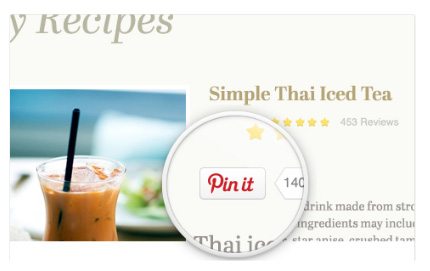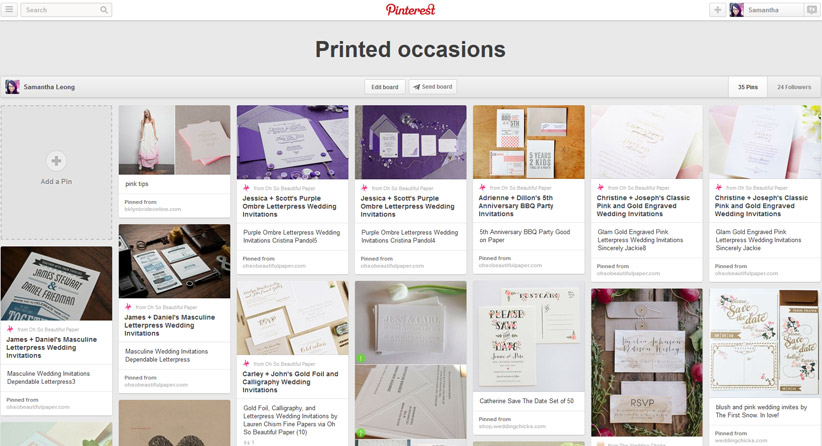Heard the term ‘pins’ and wondered what these things are? Not to worry. We’ve got you covered.
What is Pinterest?
Pinterest is a useful tool that helps people discover, ideate and organise the things that inspire and admire. In a designer’s world, think of them as mood boards. It is a way of creating a network of people with similar interests and can be used for pretty much anything. Whilst being associated with recipes, weddings, hairstyles to name a few, this social site is also used by teachers, universities, designers, not-for-profit organisations and businesses who have found other ways to use Pinterest.
How does it work?
The Pin
Pinterest is based on the idea of ‘pinning’ visual content from websites. A ‘pin’ is an image or video that can be added directly from a website to a Pinterest board (more about this later) by using the Pin it button. If you’ve got a visual website and products to show off, it’s worth adding this button to your website so people can quickly and easily add your products into the Pinterest community. From a business perspective, this brings about brand awareness and engagement.

You can also add a Pin description to help you remember what you liked about it, or instruct how something can be used by others. With Pinterest, it is more effective to write thoughtful, useful descriptions. As an added bonus, these pins also show up in search results.
Boards
Boards are like categories where you can organise your pins, and this can tell a story about your business demonstrating other ideas and interests that influence the business, or encompasses what your business is about. Featured boards could include trends, daily obsessions, architecture, patterns, shopping ideas, furniture, recipes, fashion, cleaning/care tips. The possibilities are endless.

People can follow one or all boards if it’s an area of interest to them. This will help them discover your pins as you pin them which will come up on their own home feed. The home feed consists of all the boards the user has chosen to follow, and brings all the things they’re interested in, in one place. They also have the option to Like or Repin one of your pins. The more repins and likes, the better your user engagement is.
Pinterest also allows you to create ‘secret boards’. Like a website on a staging site before going live, you can use secret boards to plan and curate your pins first before revealing it to the public. Secret boards work best if you’re sharing inspiration internally, or if you’re planning an event or new range of products and want to wait until official marketing launch.
Your Profile
Your Profile is where your boards and pins reside. As you progressively add more boards and pins, it will soon become a snapshot of who you are and what you’re interested in.
Your profile also becomes interactive. Pinterest will send you a notification each time another user likes or repins one of your pins, or follows a board you have created. This is a great way to get in touch with the Pinterest community that have similar interests.
So in a nutshell, this is how Pinterest works:
[pinterest diagram –p4 – credit – business.pinterest.com/assets/pdf/best_practices_en.pdf]
How do I get started?
We’re glad you asked! There are a number of things you’ll need to do before you can get yourself involved into the Pinterest community.
According to the Pinterest for business website it all starts with your website.
- Ideally, use decent sized high quality images. Images at least 600pixels wide will look best on Pinterest.
- Add the Pin it button to your site. The easier it is to pin from your website, the better chance your business has of getting discovered.
Once you’ve got these in check, you can set up your business account:
- Join Pinterest as a business. Create a profile that encompasses what your business is all about.
- Once your account has been setup, you can begin filling up your feed with a minimum of 5 boards to get you started. You’ll want to choose boards that are interesting to you as a business, or even find similar businesses to yours. Keep in mind that most accounts have multiple boards, so if you follow an account you automatically follow all its boards. You can also follow specific boards, and can unfollow a board at any time without the account being notified.
- Verify your account via an email confirmation. Once you have verified your account, the next screen you’ll see is your home feed which will feature the recent pins from the people you followed. The more people you follow, the more content that will show up on your feed.
Tips for business
Now you’ve got your account up and running, you want to be attracting an audience. Here are some tips to get you started:
- Install the Pin it button to your browser. The Pin it button makes it easy for you to curate content, and also references the source so you don’t come across any copyright issues.
- Download the Pinterest phone app. Manage your page and pins when you’re on the go.
- Consider who is you target audience and carefully craft your pins and boards to what they like. Also remember to keep it relevant to you as a business. This can be wide and varied from highlighting your own products, DIY, environmental sustainability, quotes, behind the scenes, exclusive pics and sneak peeks. Pinterest also has web analytics so you can see what your pinners like – a great way for your Sales and Marketing teams to utilise this knowledge and apply it to the showroom, or future ranges.
- Curate your collection. Start with a few boards and grow them from here as you add more themes. Use interesting titles and give them some personality. Choose images with great photography to draw people in. Remember, that each board is related to a specific topic, so keep it organised and ensure it doesn’t just become a dump of anything and everything.
- As well as showing off your products, use Pinterest as a platform to generate ideas and mood boards to inspire.
- Don’t be afraid to look to other businesses for help when you’re getting started. With the collaborative nature of Pinterest – Everyone needs to start somewhere and reaching out to similar businesses that have established themselves on Pinterest is a great learning curve.
- Promote your page – When you’ve got a respectable range of pins and boards, you can begin to promote your Pinterest account. This can be on your website, Facebook, Twitter, and even simple things like adding it to your email signature, or integration into your email marketing.
- Keep pinning!
Pinterest have profiled some businesses from a range of industries who have successfully used Pinterest as a medium to engage with their audience. Here are some case studies that might help you too.
For tips, tricks and best practices on using Pinterest, here’s a handy guide to get you pinning like a pro!
Whilst Pinterest is a little extra work, it’s not hard to apply. Once you get a good following and people start interacting with your pins, you’ll be helping them, and hopefully they’ll also be helping you understand what they want too.
